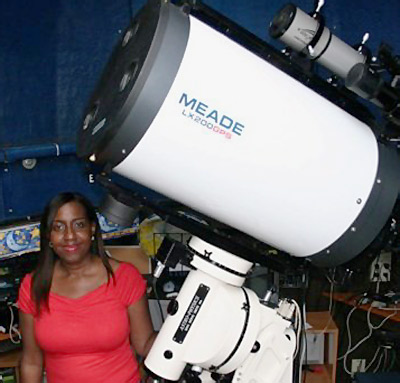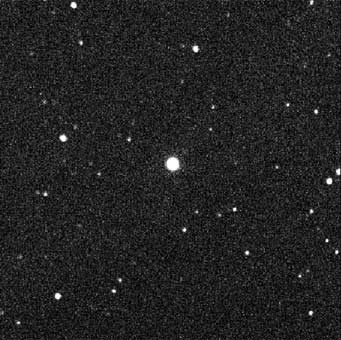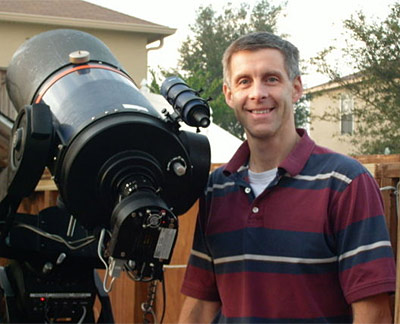On the morning of January 28th, two amateur astronomers discovered the much-awaited outburst of the recurrent nova U Scorpii, as told here yesterday. See that article for comparison-star charts and other information. Here is more about the two discoverers and how they did it.

Barbara Harris, the first discoverer, with her 16-inch scope and observatory.
Mike Simonsen
Dr. Barbara G. Harris, a retired ob-gyn doctor in New Smyrna Beach, Florida, had gone to bed late Wednesday night and really didn’t feel like getting up before the first light of dawn Thursday morning. But her dog had other ideas. It barked to go out. So she reluctantly got out of bed to open the door for the dog, and once on her feet, she stayed up. As she had done every other clear morning in January, she went outside and fired up the 16-inch Schmidt-Cassegrain telescope and CCD camera in her observatory and pointed it toward U Scorpii, low in the southeastern sky.
When the first image appeared on her computer, a huge, overexposed star was blazing right in the middle of the field. Barbara didn’t believe her eyes. Was something wrong with her gear? Just yesterday she had measured U Scorpii at photoelectric V magnitude 18.2. She quickly took another much shorter exposure, double-checked the position, “and,” she says, “that’s when I started to get excited.”

Harris's discovery image of U Sco in outburst, taken on the morning of January 28, 2010. This frame is 12 arcminutes wide. North is up.
Barbara Harris
Harris had been monitoring the recurrent nova U Scorpii for months, in anticipation of a rare eruption that was predicted by Bradley Schaefer, an astronomer at Louisiana State University. She and many other observers had joined a campaign to monitor U Sco, coordinated by the American Association of Variable Star Observers (AAVSO), that began February 2009. Now on a clear, calm morning in Florida, the moment had arrived.
“Back in December I had gotten an email from Brad Schaefer, because I had obtained the first image of U Sco as it came out from behind the Sun” into morning visibility, explains Barbara. That image had helped astronomers determine that U Sco had not blown up while it was out of sight in conjunction with the Sun. “They were sure that it hadn’t gone into outburst,” she says, “so he emailed me and thanked me, and said, keep submitting your data to AAVSO, but here’s my home phone number. Call me right away if you get something!”
As soon as Barb sent her discovery observation to AAVSO, she looked up Brad’s phone number and then thought to herself, “Let me take one more image just to be sure. I don’t want to call him this early and wake him up if I’m not sure.” At this point it was about 5:30 a.m. EST. So she took another image, calibrated and measured it, removed all doubt from her mind, and called Schaefer.

Shawn Dvorak, co-discoverer, with his automated scope and its CCD camera.
Mike Simonsen
Parallel Find
Meanwhile In Clermont, Florida, near Orlando, Shawn Dvorak was waking up to go to the gym. His telescope had been running automatically all night, taking data on several variable stars that he was monitoring for the AAVSO. Shawn had also begun checking U Sco again in January as it emerged from behind the Sun. U Sco was usually his last observation before dawn.
“I almost didn't observe it this morning since I was planning to go to the gym. I'm glad I did!” Shawn still wasn’t quite awake, and when the first CCD image came up, he thought to himself, “Whoa, I'm pointing at the wrong field, there's no star that bright here.” As Shawn describes it, “Barbara Harris spotted the outburst about an hour earlier but I hadn't heard about it yet, so it was quite a surprise to me when I saw this ‘new’ star”. Thinking the telescope had somehow missed the target, he re-imaged the field to convince himself. He then took a series of shorter exposures so the erupting 8th magnitude star wouldn’t be saturated on the CCD, and he kept taking them for the next 15 minutes as dawn quickly advanced.
About this time the phone rang in Baton Rouge, Louisiana, and, half-awake, Brad Schaefer lifted the phone to his ear. It was Barbara Harris telling him U Scorpii was in outburst. “He let out a scream and said 'Thank you, thank you! I’ll start notifying everyone right away',” Barb recalls.
Schaefer has studied the 10 known recurrent novae for years and has collected a large database of observations of all their known eruptions — including three previously unknown outbursts of U Sco that he found by searching archives of photographic sky-patrol plates going back to 1900. Based on this work, Schaefer made a bold prediction that U Sco, which last blew up in 1999, would erupt at 2009.3 plus or minus one year. This became the basis for the AAVSO's intensive monitoring campaign, and it was widely publicized in Sky & Telescope and in his recent book-length paper, "Comprehensive Photometric Histories of All Known Recurrent Novae."
But as U Sco approached conjunction with the Sun in late 2009 and still hadn’t gone into outburst, nova watchers everywhere started to get anxious.
Each time it erupts, U Sco leaps to maximum and then fades by a magnitude within just one day. It is, in fact, the fastest known nova. Its behavior this time is staying true to form. Its fast action made responding to the first sign of an outburst, and pointing large ground- and space-based telescopes in time to cover the early parts of an eruption, a daunting task. At 6 a.m. EST Schaefer was on the phone and emailing people to notify observatories and space-telescope control centers that the moment had finally come.
At 6:15 a.m., Matthew Templeton, observing-campaign coordinator for the AAVSO, was stepping out of the shower when he noticed a voicemail on his phone. It was news of the outburst. Matt swung into action, and by 6:45 the first "AAVSO Special Notice" had been sent, alerting subscribers around the world to begin observing the long-anticipated eruption.
The hope among astronomers is that, with all the advance preparation and fast notice, this will be the most thoroughly studied nova explosion in history.
At 1:30 p.m., six hours after Barbara Harris had first detected the outburst, the orbiting Rossi X-Ray Timing Explorer (RXTE) and the INTEGRAL (INTErnational Gamma-Ray Astrophysics Laboratory) satellites were observing U Sco in X-rays and gamma rays. Observations from Hawaii and New Zealand were coming in, and the international campaign to observe U Sco in outburst worldwide had begun in earnest. Over the next several months, astronomers will be monitoring it at nearly all wavelengths from radio to X-rays.
Arne Henden, director of the AAVSO, comments, "This again shows the real advantage of the worldwide distribution of amateur astronomers for detecting transient events like this. Harris and Dvorak could watch U Sco rise over the Atlantic, hours before professional astronomers in the western U.S. would have a chance. Then, because of the winter weather for most U.S. professional observatories, amateurs continued monitoring U Sco from New Zealand and Australia, catching the important first hours of the outburst."
Astronomers might have missed the beginning of the eruption if Shawn had decided to go to the gym, and if Barb’s dog hadn’t barked. “My dog has been getting cookies and anything he wants all day,” said Barb.
Follow the progress of the U Scorpii outburst on the AAVSO's news page devoted to the event. Anyone can view magnitude measurements in real time as they are submitted to the AAVSO website. For more information on U Scorpii and the AAVSO campaign, see the news page or contact Matthew Templeton, matthewt(AT)aavso(DOT)org (617-354-0484).
------------------
Mike Simonsen, one of the world's leading variable star observers, is development director for the American Association of Variable Star Observers in Cambridge, Mass., and heads its Cataclysmic Variable Section, Chart Team, and Mentor Program. He writes the astronomy and variable star blog Simostronomy and is a cast member of the Slacker Astronomy podcast..
 10
10
Comments
Bpb Peterson
January 29, 2010 at 5:55 pm
Congrads, Dr. Harris, from a former member of CFAS. Up here in Appleton WI it has been rather chilly for early morning viewing!
Bob
You must be logged in to post a comment.
Dr. R.A.N.S. Rajapakshe
January 30, 2010 at 9:37 am
your dedication is highly appreciated. The most important thing was that time. Any way convey my regards to your dogie too...
You must be logged in to post a comment.
Kurt Bauc
January 31, 2010 at 2:36 pm
Wow, that's great! Dr. Harris - do you have a website where we can check out your observatoy and other feats? And is that a mask for focusing on your scope?
You must be logged in to post a comment.
jaime
February 3, 2010 at 10:36 pm
You both have a fresh intensive pleasure for `God`s creation.I wish that you,and many others like you, continue obtaining more celestial events & discoveries.read; http://www.Yahushah.net/astronomy.html
You must be logged in to post a comment.
Tyler Pieters
March 24, 2010 at 1:39 am
Congrats on the news!!!
and i think that cover over his scope is a dew cover.
You must be logged in to post a comment.
Bob Derouin
March 25, 2010 at 2:14 pm
Congratulations on your brilliant work, Dr. Harris!!!
You must be logged in to post a comment.
Ashlynn
April 20, 2010 at 2:12 am
Speaking of eruption, another volcano in Iceland had been erupted. Want to start a rumor and don't know how to get it around. I do, use twitter. Thatâs just what happened when someone put a "tweet" online the Hekla Volcano erupted. The news spread fast and before you knew it there were worldwide rumors the 9th deadliest volcano in Europe had erupted. Mt. Hekla is in Iceland and is estimated to take with it up to 10,000 people when it does erupt. So needless to say this rumor had numerous people in a panic and on call with friends and family.
You must be logged in to post a comment.
Greg
July 1, 2010 at 2:59 am
Congratulations to Barbara and Shawn! Lucky you are, I shoul admit. As a rule, such discoveries are made occasionaly. I can fancy the feelings of these guys, when they discovered such a phenomenon!
Good work!
http://paydaylending.blog.com
You must be logged in to post a comment.
Mike STephen
July 7, 2010 at 9:58 am
Congratulations to him. he has done a really good achievement. Such discoveries are rare to see these days.
pneumonia symptoms
You must be logged in to post a comment.
DaveP
October 15, 2010 at 12:59 am
It's a great news, really! Astronomy is my hobby, but I was always dreaming about such kind of discovery. I even took some cash advance online to buy a good telescope. It's so great, I think, to make such contribution in the global science. These amateurs make a good deal. Well done!
You must be logged in to post a comment.
You must be logged in to post a comment.